ESTATE OF SARAH HUNTER HICKS GREEN OF DEVON FARM – 225 YEARS OF NASHVILLE HISTORY
“If you looked up Southern Belle in the dictionary, you’d find a picture of Sarah Hunter Hicks Green.”

That’s how friends described this remarkable lady, a fixture on the social circuit in Nashville and Naples, former Swan Ball chair, and guardian of her family’s storied history. The only child of Edward Dickson Hicks IV and W. Hunter Giers, she inherited Devon Farm, a former plantation on the edge of Belle Meade, which had been inher family since her ancestor John Davis settled there in the 18th century. She also inherited an archive of photographs taken by her grandfather and great-grandfather, Otto and C.C. Giers, documenting Nashville’s growth as a city and its people, from Civil War generals to slaves.
Case is honored to present Mrs. Green’s coveted collection of jewelry, including a 8.03 carat diamond ring in platinum JB Star mounting, and antique furniture, silver, art, and historical items from Devon Farm, including a rare land document signed by the founder of Nashville, James Robertson. Several of the objects being sold in this auction have been exhibited over the years or illustrated in books. Bidding is open now through auction day, July 30, 2016, with bidding available in person, by phone, or online. See our full catalog at www.caseantiques.com for more information.
HISTORIC DEVON FARM
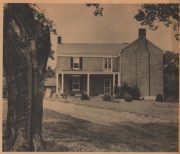
Named for the world famous cattle that were bred here, Devon Farm (located on Hwy 100, just outside Belle Meade), was owned by seven generations of Davis-Hicks descendants. A 1952 feature article in the Tennessean newspaper surmised it was the oldest house in continuous use by the same family in Davidson County. The original property was acquired by John Davis (1770-1853) or his father Frederick Davis (1748-1831) as a Revolutionary War land grant.
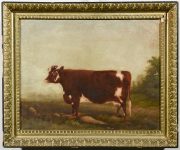
The hand-made brick home itself is believed to have been built by Giles Harding (father of General John Harding of Belle Meade Plantation), who in 1798 purchased the tract upon which it sits. Giles Harding’s son, David Morris Harding, married John Davis’s daughter Fanny, and built it into a thriving plantation called Oak Hill. When the couple died childless, the land and home passed to Fanny’s nephew (John Davis’s grandson), Edward Dickson Hicks II. Hicks, who had begun importing and breeding Devon cattle, changed the name to Devon Farm. By 1888, he owned a herd of 140 Devons which, according to The Tennessee Farmer, was “probably the largest herd of Devons in the United States.” Edward Dickson Hicks III strengthened the agricultural dynasty when he married Harriet Cockrill, daughter of Mark Cockrill, the world famous breeder of Spanish Merino sheep. Their son, Edward Dickson Hicks IV, founded the Dobson-Hicks Seed Company in 1926, and developed the Hicks Yellow Dent corn, used before hybrid varieties – all while continuing to farm the land. Devon Farm was listed on the National Register of Historic Places in 1974. In 2002, the property was sold and became the home of Ensworth High School. The house still stands.
Family Members Represented in This Sale
Over the last 225 years, members of the Davis-Hicks-Giers family played key roles in Nashville’s landmark moments – from its days as a frontier outpost, to the Civil War, to the creation of the city’s Metropolitan Government in the 1960s.
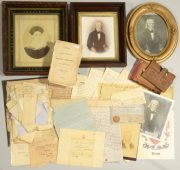
JOHN DAVIS – Born in Eastern North Carolina in 1770, died Nashville 1853. By some accounts, he fought in the Revolutionary War as a teen. Other accounts say it was actually his father, Frederick Davis, who fought, securing the land grant that prompted 18 year old John Davis to strike out for what was then Davidson County, North Carolina. (Note: the 1828 Sam Houston signed land document for sale in this auction, transferring property from Frederick Davis to John Davis, may reference this land).
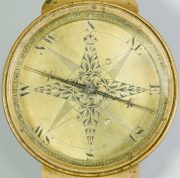
Davis fought Indians in the territory, doing battle at Buchanan Station in 1792, and worked as a Davidson County surveyor (his compass and gunter’s scale, and several of his hand drawn maps, are being offered in this auction). He brought his entire family, including Frederick Davis and sister Ciddy Davis (who would marry the son of Nashville founding father James Robertson), to Davidson County. In 1798, he began a family of his own by marrying a Virginia-born girl, Dorcas Gleaves. One of their daughters, Nancy Davis, married Edward Dickson Hicks, but the young couple died not long after she gave birth to their son, Edward Dickson Hicks II. John and Dorcas Davis raised the child, and all the while, John Davis was surveying and amassing land. The property around their farm grew, as did the red brick home, and by the time of his death in 1853, Davis’s legacy included more than 30,000 acres of land – and, according to his obituary, “an unspotted reputation for integrity and honesty, which was never questioned.”
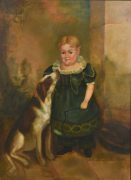
EDWARD DICKSON HICKS II was born in Nashville in 1831, and raised by relatives after the early death of his parents. Possessed by an adventurous streak, he put on his spurs and rode west for the Gold Rush, as detailed by his diary. He returned home in the 1850s and began farming his family’s land. He also started a family of his own, marrying Mary Ann White. When the Civil War broke out, Hicks joined the Confederate Army, serving as Adjutant Major, First Battalion, Tennessee Cavalry. (His Civil War era diary, Tactics Manual, and resignation papers are included in this auction). Hicks’ reasons for resigning are unclear. He turned his focus to farming, and upon inheriting Oak Hill Plantation from his aunt Fanny Harding, he began importing English Devon Cattle and renamed the land Devon Farm. Although unsuccessful in the Gold Rush, Hicks went on to make his fortune through farming and business interests. He was a director of the Nashville Commercial Insurance Company and the Nashville, Chattanooga and St. Louis Railways, and served on the board of trustees at the University of Nashville. He died a wealthy man in 1894. His son, Edward Dickson Hicks III, strengthened the agricultural dynasty when he married Harriet Cockrill, daughter of Mark Cockrill, the world famous breeder of Spanish Merino sheep. Their son, Edward Dickson Hicks IV, founded the Dobson-Hicks Seed Company in 1926, and continued the tradition of civic involvement, helping establish the Nashville Farmer’s Market and serving on the commission that created Nashville’s Metropolitan Government in the 1960s.

CARL C. GIERS immigrated from Germany and arrived in Nashville in 1852. He set up a photo gallery downtown, photographing many Nashville occupants and visitors – including notable Civil War figures during the city’s Union Occupation. In 1874, both Republicans and Democrats nominated him as a candidate for the Tennessee General Assembly. He served in the House of Representatives in 1875, and made photograph albums of each House. He served as Tennessee’s delegate to the World Exposition in Vienna, and put together Tennessee’s exhibition at the U.S. Centennial Exposition in Philadelphia in 1876. C.C. Giers passed away in 1877 and the studio was sold. His son, Otto Giers, only 19 when his father died, took up the trade several years later and continued it as part of the firm Thuss, Kollein and Giers. Otto Giers went on to make a name for himself photographing a series of documentary photos of the city of Nashville (included in this auction), the Nashville Centennial Exposition, and other important citizens, sites, and events. Later in life, he had a career with Nashville government, serving as assistant treasurer and with the waterworks department. His only daughter, Hunter, married Edward Dickson Hicks IV; Sarah Hunter Hicks Green was their only child.
ESTATE OF HENRY AND JEAN YEATMAN OF HAMILTON PLACE PLANTATION
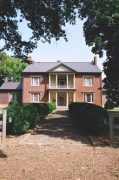
Shortly after the American Revolution, Colonel William Polk (1758-1834; a cousin to President James K. Polk) won or purchased a 5,648-acre tract of land from the governor of North Carolina (the land was considered part of North Carolina prior to Tennessee statehood; the area is now known as Maury County, Tennessee).
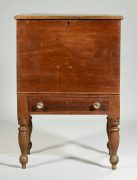
Part of the land he gave to his son Lucius Junius Polk (1802-1870). (Other parts of the original tract contain St. Johns Episcopal Church and Rattle & Snap). Lucius Junius Polk built Hamilton Place on his tract in 1832, and around the same time married Miss Mary Eastin (a niece of President Andrew Jackson, who had served as Jackson’s White House hostess). The couple were married at The White House and were visited at Hamilton Place by three U.S. Presidents: Andrew Jackson, James K. Polk, and Martin Van Buren. Mary died in childbirth in 1837, and years later, Polk gave his land and house to his daughter Mary Brown Polk (1835-1890) and her husband Henry Clay Yeatman (1831-1910), a Nashville lawyer and Confederate Colonel.
They left the house and land to their son Trezevant Player Yeatman (1871-1959). Around 1971, at the death of his wife Mary Wharton Yeatman, the land, house, and contents were left to children Trezevant Player Yeatman (1914-1996), Henry Clay Yeatman (1916-2003), and Mary Jane Whiteside (1918-2001). Hamilton Place and most of the land around it was then sold.
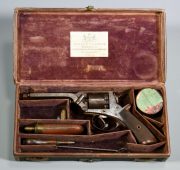

Now that Henry Clay Yeatman (1916-2013) and his wife Jean Anderson Yeatman (1928-2015) have passed away, their children, Clay Yeatman and Jean Hansford Yeatman, have made the decision to find new owners for much of the silver, china, crystal, furniture, antique guns, portraits, books, and other remarkable antiques.